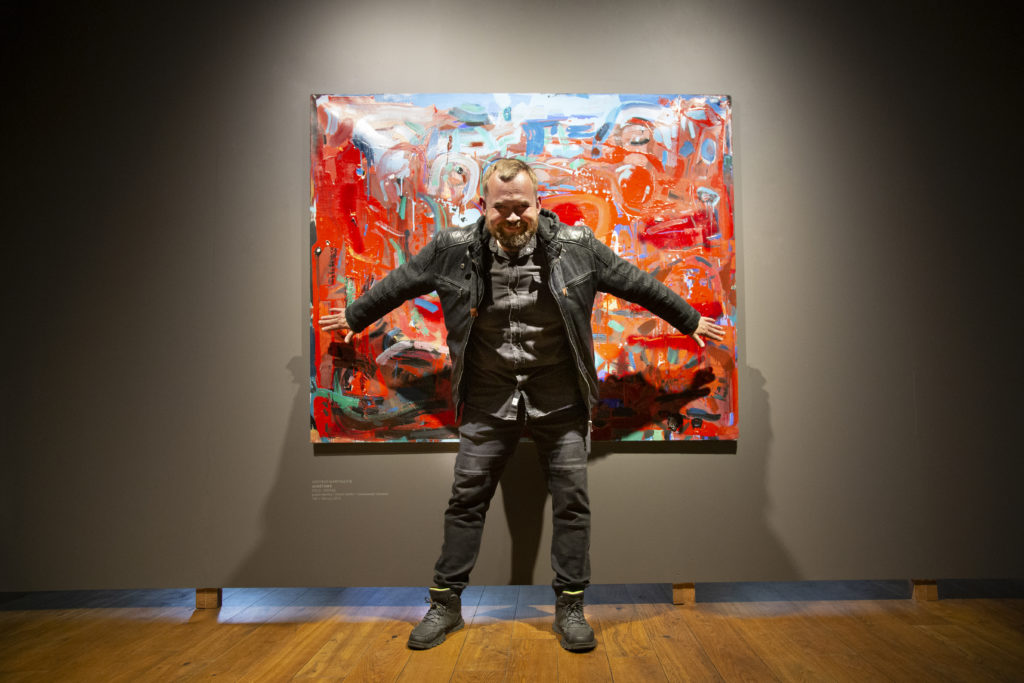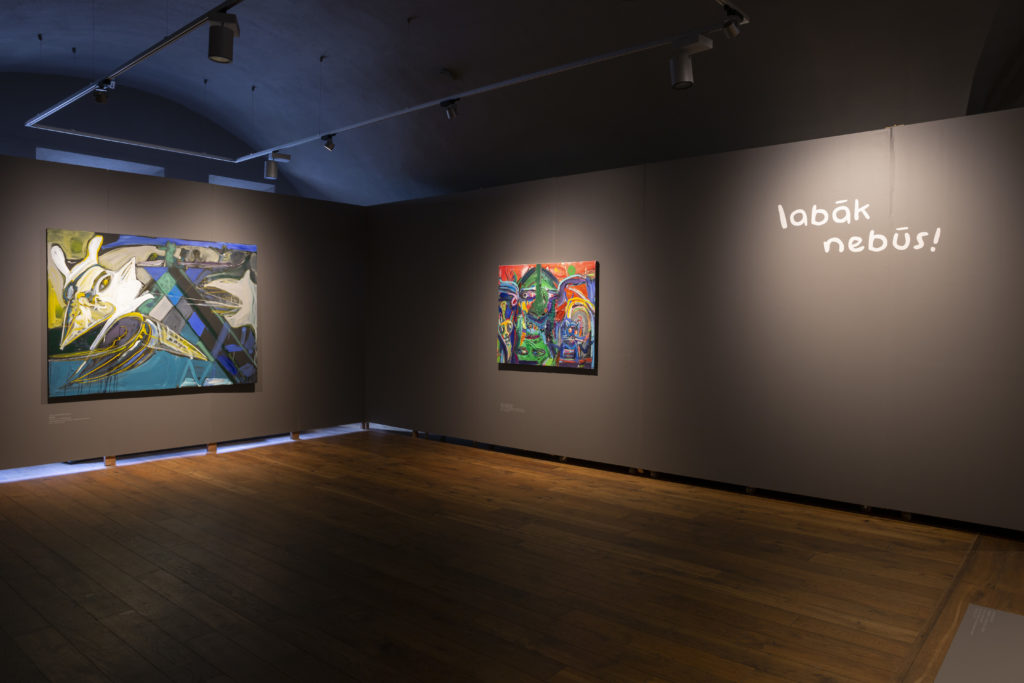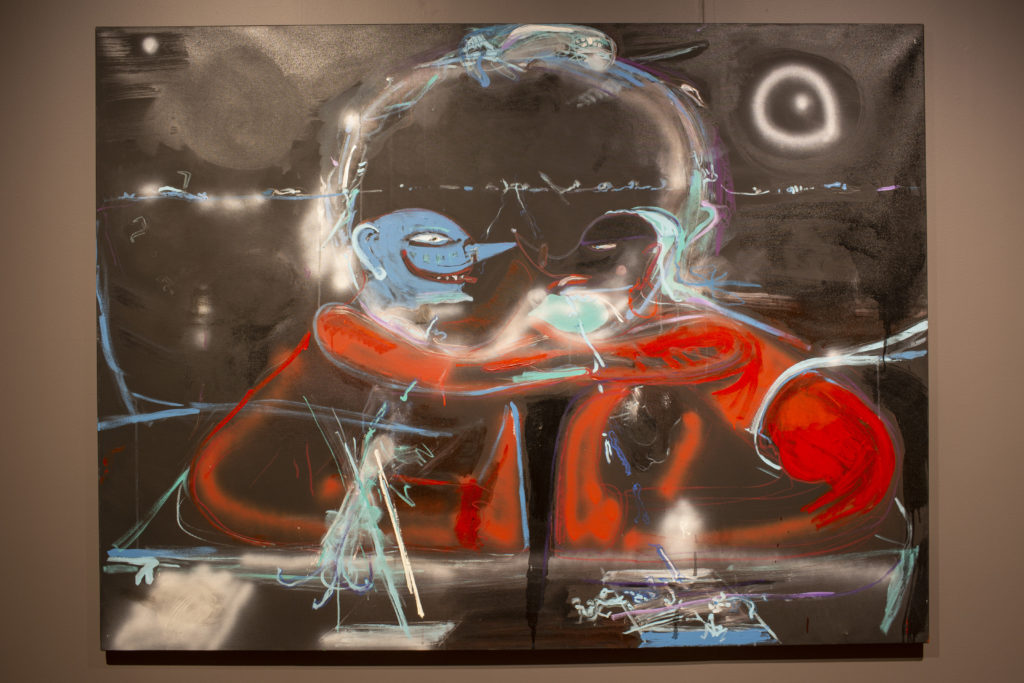Hallway talks with Arvydas Martinaitis (Lithuania)

The Rothko Centre: Your exhibition title says “It Won’t Get Any Better than This”. It really won’t?
Arvydas Martinaitis: You know, I’ve always wanted to keep surprising my viewers with something new. Shaking them up a bit. So the title is just a pun. Things will get better; of course, they will! And there’s another meaning there, too – allegedly, you won’t see a better, more exciting exhibition because this one’s as good as they go (laughs). But, again, that’s hardly the case. We keep going, and there’ll surely be more to intrigue and spark your interest.
RC: Right now, we don’t have many reasons to laugh, but your exhibition seems to be giving people a licence to be happy. Your humour and irony, where do you get them?
AM: From my granddad. My father was a painter, a great artist, real as you get, but my granddad specialised in watercolour and caricature. So one day, I was on a plein air when the editor of a Lithuanian newspaper told me my paintings reminded him of my grandfather’s work. That my style was similar to his. More so than my father’s manner of painting. After all, humour and caricature go hand in hand. So I seem to have inherited the gene.
RC: I try to imagine you as a child, and it seems you were quite a handful. A right little rascal, no?
AM: Well spotted (laughs). By no means a malicious roughneck, I did get into a few scrapes. But then again, in Soviet times, if you didn’t do well in school, you couldn’t go to university and move up in the world. So one had to try and stay on the straight and narrow and put in an effort. So, in the end, I did the full range, from vocational school to art academy. And every school gave me some skills I still use as a painter. At first, I trained as a painter and decorator and got my secondary education. Then I did a college course in restoration. And then came the art academy in Vilnius, where I studied painting.
RC: Coming as you do from such a creative family, you must have loved drawing from an early age.
AM: Not really, no (laughs). My father was a famous artist, and when we were out together, I was often asked if I liked drawing. And I’d usually snap – no, I don’t! But when my father passed away (he was just 47!), I was desperate to reconnect. How? Only through drawing and painting. So when I was studying painting and decorating, I already knew I wanted to be an artist. And I applied to an art college. I’d hoped to learn restoration, but they took people after the ninth grade, and I’d already finished secondary school. So I played a smart trick – I applied to the design group and then asked for a transfer to restoration. Yep, you could do that!

RC: A lush palette, a distinctive brushstroke and texture… It’s pretty clear from your work that you’re an oil buff.
AM: Perhaps it’s due to my background as a painter and decorator that I have this bold brushstroke and these crazy colours (laughs). And my special technique. You know, there’s this particular technique when your entire painting is done with a spatula. But it’s not just the oils, I also love acrylic and watercolour.
RC: Oil painting is rather time-consuming, so it takes lots of patience.
AM: I cheat with the tricks I learnt as a construction worker. I take the paint they use in construction due to its fast-drying properties. Granted, it’s tough work on account of the terrible smell. Goes straight to your head. But the pandemic has taught me a way around it –just put on a face mask… and it’s not so bad. And there’s much less competition in this line of work.
RC: But you do other things besides painting, right?
AM: I paint a bit, and I teach basic photography. And I’ve been an exhibition curator for the past twelve thirteen years.
RC: Sounds pretty busy…
AM: Yes. But I’m up to here with most of it (smiles). Most likely because the students have changed so much. It’s a whole different breed now. Their approach and attitude no longer inspire. Smartphones, computers… don’t get me wrong, they’re perfectly fine! But we seem to have lost something genuine and alive. I’ll give you an example. We’re drawing a still life from a setup. And one of my students just snaps a picture and draws from his phone (laughs). I mean, who does that?… I tell him – come on, look at the object! It’s right in front of you! Some people just can’t be bothered. I knock myself out, trying to spark an interest, and end up thinking – what’s the point?… (shrugs). It almost makes you want to throw in the towel. But another summer passes, and I hitch myself in for another ride. I want to emphasise contemporary painting, tweak the programme, work my socks off, and still end up hitting a wall… Don’t get me wrong, the students aren’t all bad. I get a few I really like to work with. Usually, at my Saturday course. Now those people really have the drive. I mean, of course they do. And still, I sometimes feel bored to tears. Guess I’m at a stage when I’d like to live for myself, not others.
RC: And what would that mean?
AM: Only painting.
RC: That’s it? Or do you have other things that inspire you?
AM: (smiles) You know, there was a time I wanted to be a gym trainer. After all, I work out, and I really love it. A legitimate job, only in sports. Right up my alley!
RC: Would you agree that performance has lately become a leading art form?
AM: We need everything, the full works. After all, performance art has a pretty short lifespan. A couple of years, and everybody will have forgotten (with a few notable exceptions).
RC: What’s your favourite subject in painting?
Am: I’m a universal artist – I do people, still lifes and landscapes.
RC: And what about formats?
AM: I like working on a large scale.
RC: What’s the best thing about it?
AM: Well, with smaller formats, you tinker and tinker, and something still feels undone. Never so with the larger ones. I paint the picture, and I’m happy right away. And the feeling stays!
RC: And what about when you’re unhappy with your work? Do you know the pain of creation?
AM: I sometimes look at my paintings from a couple of years back, and I don’t like them. So much that I want to do them over. Sometimes I actually go and do it. Or simply bin them. No more than one in ten will pass my inspection. And I mostly rely on my gut. So I hang the thing up, and I wait. If it doesn’t seem right in two weeks, it’s not staying.
RC: When do you share your paintings as gifts?
AM: When I fall in love (laughs). No, but seriously, I give away very rarely. Only for very special occasions, if I feel the person really likes it.
RC: Who are your role models in art?
AM: My father. I’m sorry we didn’t get to sit down and chat about painting and argue out our perspectives. He lived the life of a true artist and played as hard as he worked. And he was very kind, maybe too kind. People took advantage. He left many paintings, many works. You see, my father painted in the old style, with oils. He’d work on ten pieces at once, letting the paint dry in circles. I love Rothko. He was different. Love his pure colours and harmony. Although I also like dissonance, chaos and loss of balance.
RC: The artist paints one thing and has one idea, but the critics see something else. Have you been there?
AM: Sometimes, when critics start dissecting your work, you can’t help wondering – really?! You simply experienced a strong emotion, the proverbial kick in the gut, and just painted it out without thinking about deeper meanings.
RC: What’s your favourite thing about plein airs?
AM: I adore plein airs! You get different people, stories and experiences. The spirit of adventure, the thrill of the unpredictable. But it’s no walk in the park – you’re dealing with artists! Take this one case. We had Jewish artists over from Israel, where the pandemic had kept them on the strictest lockdown, confined to within three hundred metres from home. And here they were finally free, so they took a car and went driving around Lithuania with friends. Really knocked themselves out. Of course, the guys caught the Delta and passed it to our curator and me. Luckily, nobody else got hurt. But we all duly sat out our quarantine. I’d had family plans to go to Liepāja, but when it was finally possible, the weather turned, and the rain set in. So that’s when I said – no more plein airs, I quit (laughs).

RC: How have you been since the tragic events in Ukraine?
AM: The war hit me hard. Innocents suffer and die, and I feel so powerless…
RC: What keeps you afloat?
AM: The developments in Ukraine have us grappling with rage, irritation and outright fury. Like many artists, we’re looking for ways to process it, vent our frustrations, ease the tension, express where we stand through our work, and support the Ukrainian people in these incredibly tough times. For many, work becomes therapeutic. We all feel rattled and totally wretched. So we must try and keep ourselves together and do all we can to stop the world from falling to pieces.
